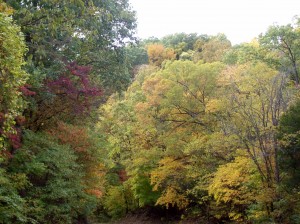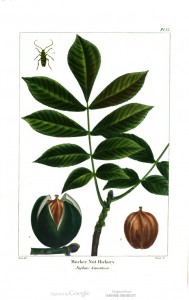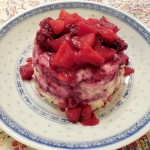14 Octobre, Lundi (Monday)
65 degrees F
Cloudy, 5 mph ESE wind
Les récoltes d’Octobre
Autumn is a season of both last and first harvests in Upper Louisiana. The jardin potager(kitchen garden) vegetables will soon bear to fruition the fall crops of beans, lettuces, peas, radishes, and turnips. With temperatures cooling, preparations begin for next year’s garden by clearing and amending the soil held within the raised beds. The leaves of the forest have rapidly begun wearing their autumn colors ranging from gold to red, signaling the slowing of our daily garden work. As we near the first frosts, the stillroom tasks of seed saving, herb drying, and vegetable preserving will soon slow. Stepping away from the garden and its tasks, the orchard and forest beckon with additional crop opportunities, with many native nuts and fruits ready to be harvested. Noted in the travels of accounts of Upper Louisiana, the Illinois country in colonial times offered a varied selection of fruit and nut trees, both cultivated and native. Jean-Benard Bossu’s account in his Travels in North America, 1751-1762, recounts this bounty. First he gives mention of the fruit of the native persimmon and pawpaw. He further describes:
There are many orange and peach trees. Oranges and peaches are so plentiful that colonists let them rot on trees. There are black nuts, or hickory nuts, and walnuts. Just as in Europe, there are fair sized ones that are good to eat and others, as big as a fist, which are bitter and have a very thick, hard shell. The pecan trees bear nuts which are long, like almonds, but more delicate in flavor. The Indians make oil of them which they use in corn meal mush.*
Once finished gathering or harvesting in the garden and forest, we take our produce into the kitchen. Our choices are to use immediately or preserve. This Saturday, a discussion and demonstration of the 18th century Art of Preserving, Conserving, and Candying will be presented, with my friends Antoinette Hancock and Renea Davis. Meet us in the Fort’s store building at 10 AM, a free event venturing into past colonial preserving techniques. Autumn produce in pudding and cake receipts are delicious ways to use extra fall produce; regional and eighteenth-century cookbooks abound with recipes. Newly added autumn recipes are listed on the 2013 Recettes page of this blog.
The fall season is a wonderful time to travel the Illinois country, as many communities celebrate the autumn season. Additional events at Fort de Chartres this fall include a Bake Oven Certification Class on Saturday, October 26, and the Winter Rendezvous and Woodswalk, November 2 & 3. For more information about these events, visit the Evénements page. Explorez l’automne dans la région de l’Illinois.
* Jean-Bernard Bossu, Jean-Bernard Bossu’s Travels in the Interior of North America 1751-1762, ed. and trans. by Seymour Feiler (Norman: University of Oklahoma Press, 1962)



Oh, I WANT a copy of that book! Didn’t know it existed–does it focus on Louisiana Territory? The ones I have that do are a bit later…
The jardin is beautiful and I envy your work there with those dear ladies. Do you culture anything? I’ve been making pickles, kraut and such…
Kate, I bought a used copy on Amazon about 5 years ago. There is a good portion in Volume 1 about his travels in Louisiana and into the Illinois country. It is available for reading on line: http://archive.org/details/cihm_62262
Yes, I am currently pickling and I explore other culture recipes, when the crop or time warrants. Not enough hours in the day! Thank you for the kind garden compliment. As a gardener and history aficionado, it is so satisfying to make the 18th century come alive through exploring the 18th century foodways of this part of the world so rich in history.